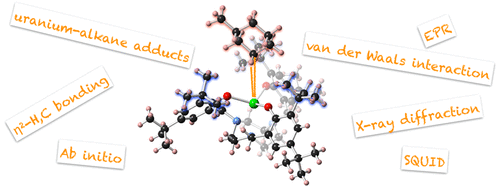当前位置:
X-MOL 学术
›
J. Am. Chem. Soc.
›
论文详情
Our official English website, www.x-mol.net, welcomes your
feedback! (Note: you will need to create a separate account there.)
Dispersion Forces Drive the Formation of Uranium-Alkane Adducts
Journal of the American Chemical Society ( IF 14.4 ) Pub Date : 2019-12-29 , DOI: 10.1021/jacs.9b10620 Julie Jung 1, 2 , Sascha T Löffler 3 , Jan Langmann 4 , Frank W Heinemann 3 , Eckhard Bill 5 , Giovanni Bistoni 1 , Wolfgang Scherer 4 , Mihail Atanasov 1, 6 , Karsten Meyer 3 , Frank Neese 1
Journal of the American Chemical Society ( IF 14.4 ) Pub Date : 2019-12-29 , DOI: 10.1021/jacs.9b10620 Julie Jung 1, 2 , Sascha T Löffler 3 , Jan Langmann 4 , Frank W Heinemann 3 , Eckhard Bill 5 , Giovanni Bistoni 1 , Wolfgang Scherer 4 , Mihail Atanasov 1, 6 , Karsten Meyer 3 , Frank Neese 1
Affiliation

|
Single-crystal cryogenic X-ray diffraction, electron paramagnetic resonance spectroscopy and correlated electronic structure calculations are combined to shed light on the nature of the metal-tris(aryloxide), and η2 - H, C metal-alkane interaction in the [((t·BuArO)3tacn)UIII(Mecy-C6)]•(Mecy-C6) adduct. An analysis of the ligand field experienced by the uranium center using \textit{ab initio} ligand field theory in combination with the angular overlap model yields rather unusual U-OArO and U-Ntacn bonding parameters for the metal-tris(aryloxide) interaction. These parameters are incompatible with the concept of σ and π metal-ligand overlap. For that reason, it is deduced that metal-ligand bonding in the [((t·BuArO)3tacn)UIII] moiety is predominantly ionic. The bonding interaction between the [((t·BuArO)3tacn)UIII] moiety are shown to be dispersive in nature, and essentially supported by the upper-rim tBu groups of the (t·BuArO)3tacn3- ligand. Hence, our findings indicate that the axial alkane molecule is held in place by guest-host effect rather than direct metal-alkane ionic or covalent interactions.
中文翻译:

色散力驱动铀-烷烃加合物的形成
结合单晶低温 X 射线衍射、电子顺磁共振光谱和相关电子结构计算,揭示了金属-三(芳基氧化物)的性质,以及 [(( t·BuArO)3tacn)UIII(Mecy-C6)]•(Mecy-C6) 加合物。使用 \textit{ab initio} 配体场理论结合角度重叠模型对铀中心经历的配体场进行分析,得出金属-三(芳基氧化物)相互作用的相当不寻常的 U-OArO 和 U-Ntacn 键合参数。这些参数与 σ 和 π 金属配体重叠的概念不兼容。因此,推断[((t·BuArO)3tacn)UIII]部分中的金属-配体键合主要是离子键。[((t·BuArO)3tacn)UIII] 部分之间的键合相互作用在本质上是分散的,基本上由 (t·BuArO)3tacn3- 配体的上缘 tBu 基团支持。因此,我们的研究结果表明,轴向烷烃分子是通过客体效应而不是直接的金属-烷烃离子或共价相互作用固定的。
更新日期:2019-12-29
中文翻译:

色散力驱动铀-烷烃加合物的形成
结合单晶低温 X 射线衍射、电子顺磁共振光谱和相关电子结构计算,揭示了金属-三(芳基氧化物)的性质,以及 [(( t·BuArO)3tacn)UIII(Mecy-C6)]•(Mecy-C6) 加合物。使用 \textit{ab initio} 配体场理论结合角度重叠模型对铀中心经历的配体场进行分析,得出金属-三(芳基氧化物)相互作用的相当不寻常的 U-OArO 和 U-Ntacn 键合参数。这些参数与 σ 和 π 金属配体重叠的概念不兼容。因此,推断[((t·BuArO)3tacn)UIII]部分中的金属-配体键合主要是离子键。[((t·BuArO)3tacn)UIII] 部分之间的键合相互作用在本质上是分散的,基本上由 (t·BuArO)3tacn3- 配体的上缘 tBu 基团支持。因此,我们的研究结果表明,轴向烷烃分子是通过客体效应而不是直接的金属-烷烃离子或共价相互作用固定的。











































 京公网安备 11010802027423号
京公网安备 11010802027423号